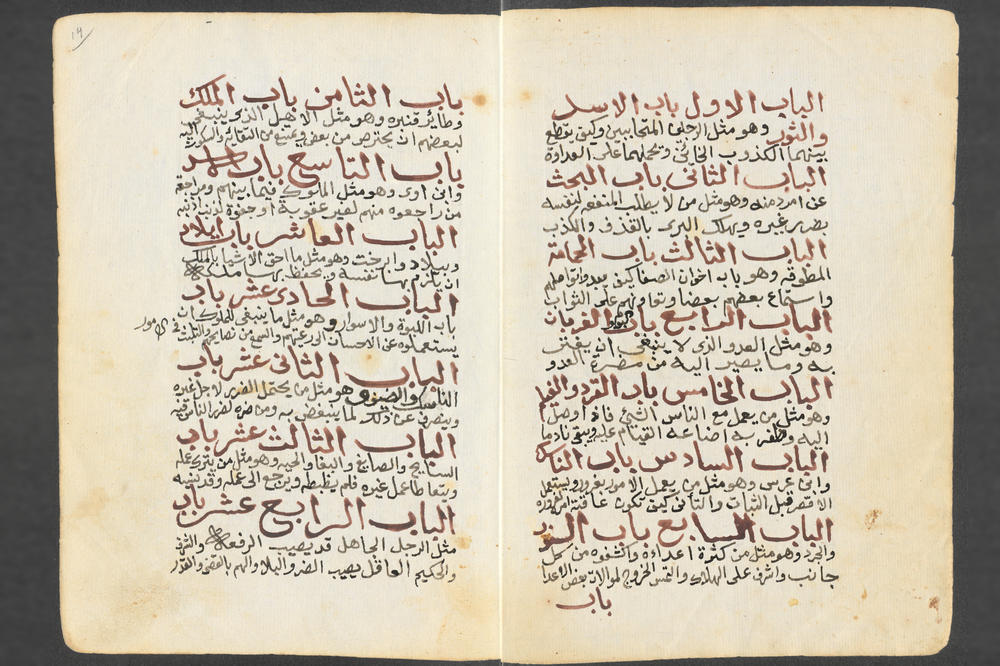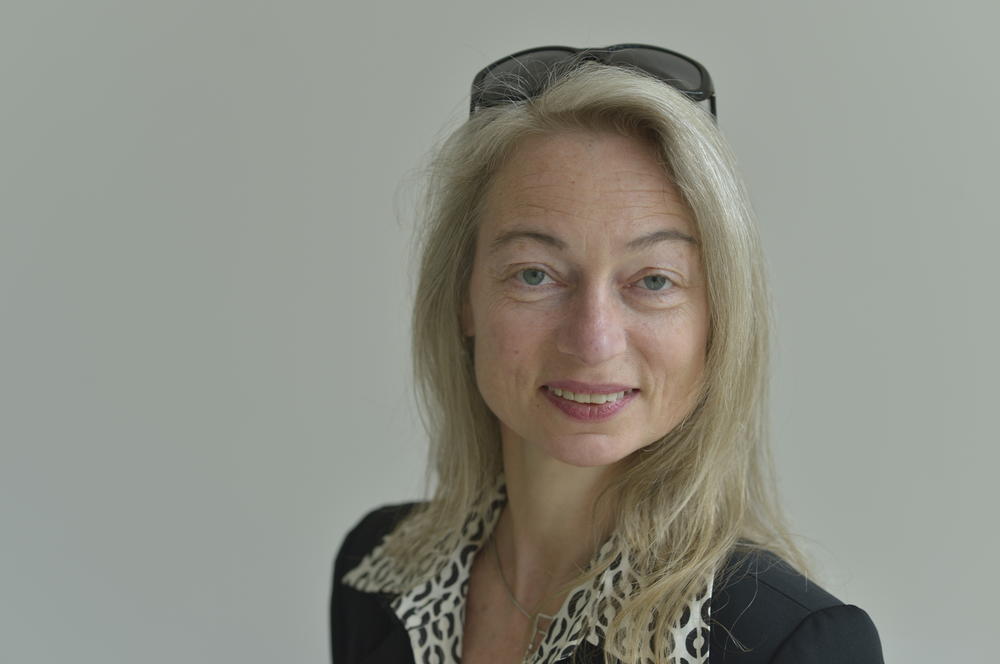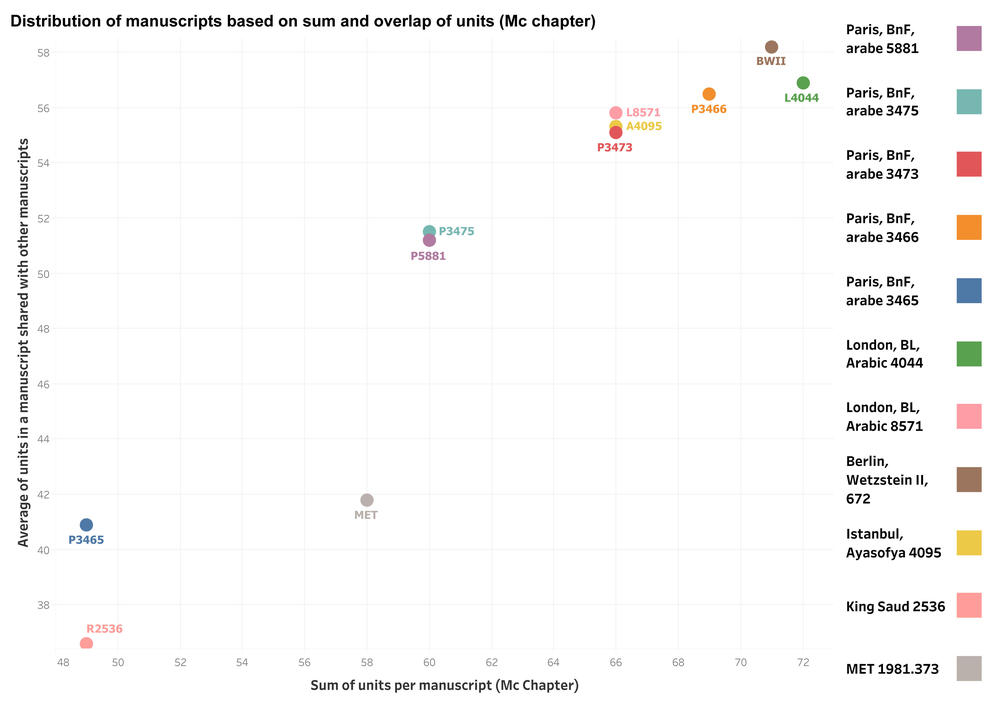An Archaeologist of the Written Word
An expert in Arabic studies, Beatrice Gründler of Freie Universität advocates a more sophisticated approach to Arabic Islamic culture. In 2017, she was awarded the Leibniz Prize for her work.
Oct 05, 2017
“Kalila and Dimna” is a widely known collection of Arabic fables. This is the list of contents of the edition by Ibn al-Muqaffa’ copied in 1830 by Ahmad al-Rabbat who owned a lending library of popular Arabic literature.
Image Credit: Staatsbibliothek zu Berlin, MS Wetzstein II 672 fol. 13v (ToC pt. 1, rechte Seite) und fol. 14r (ToC pt. 3, linke Seite)
“I grew up close to the French border, in a small town with an inland harbor,” Beatrice Gründler says when explaining her passion for languages in general, and Arabic in particular. “There were people of all colors where I come from, and learning to speak other languages was something very pertinent. I discovered that when you speak several languages, you develop a different personality in each of them.” Her father, a graphic artist, was another influence. He helped her develop an eye for the written word and appreciate languages and their inherent aesthetic characteristics. Studying Oriental studies and Semitic studies in Strasbourg, Tübingen, Cairo, and at Harvard University, Gründler immersed herself in ancient scripts and learned cuneiform writing. “I was like a child in a candy store.”
At the age of 15, she found a volume on hieroglyphics in an antiquarian bookshop and used her savings to buy it. For weeks and months, Gründler studied its strange symbols, delighted in its beautiful illustrations, and came to the realization that “image, writing, and culture are all one and the same thing.” To suggest that the youthful enthusiasm of this future professor of Arabic studies was perhaps unusual is to prompt an immediate demonstration: from a bookcase, Gründler pulls the book she used to teach herself Arabic. Enthusiastically, she shows the different aesthetics of the two scripts: the imagery and mystery of shapely hieroglyphs, as against the minimalist elegance and efficiency of the Arabic alphabet.
An Ardent Student of Script and Language
Nearly 40 years after her first incursions in the Arabic language, Gründler’s enthusiasm for writing and language – together with their historical and cultural aspects – has not waned. Following 27 years in America, Gründler now teaches and does research at Freie Universität as a professor of Arabic studies. She is also the director of studies at the Berlin Graduate School Muslim Cultures and Societies and at the Friedrich Schlegel Graduate School of Literary Studies, supervises doctoral candidates, invites colleagues from abroad to Berlin, and initiates joint research projects. Gründler’s energy is unfailing and her enthusiasm is a great boost to the interdisciplinary exchange of ideas. In recognition of this, the DFG awarded the Leibniz Prize, worth 2.5 million euros and one of the highest accolades in European research, for her project “On the Diversity of Voices in Arabic Poetry and Culture.”
Gründler understands her department’s task, among other things, as helping to contribute to public discussion and providing expert knowledge. “I am happy if we can help Arabic studies’ scholars to consider Arab-Islamic culture in public discourse in a more nuanced way and to disseminate more knowledge on the topic.” She feels that current coverage of Islam, which has increased significantly in recent years, is relatively balanced. “After the 9/11 attacks in the U.S., students were almost pouring through the doors, such was public interest in the culture. Often, there is a lack of expert knowledge during a crisis. At such times, one must seize the opportunity to speak.”
Replicating the Wanderings of Manuscripts
Beatrice Gründler’s research has won her several awards, including the 2017 Leibniz Prize.
Image Credit: Bernd Wannenmacher
in its Arabic version. Her research benefits from an ERC (European Research Council) Advanced Grant, which was also awarded in 2017. “For me, a historical/critical edition of the collection is truly close to my heart,” she says. Her colleagues in Arabic studies and Islamic studies are all familiar with the fables, which were originally intended to serve in the moral education of future rulers. In the stories, enraged wives empty bowls of food over the heads of rulers, deflating monarchs egos with wholesome parables and words of wisdom. There is much about the meaning of friendship and the right way to behave in society, but also about political tactics. “These stories are still fascinating today. The introductory courses use Kalila and Dimna as a way of teaching Arabic and starting a conversation about the interpersonal content of the fables,” says Gründler.
The collection of fables cannot be traced back to one author, since there have been multiple translations, additions, and adaptations – in fact, an unfathomable sea of manuscripts which arose over a period of more than 1000 years and which have wandered far and wide across the regions of the world. “Over its long history, the text has changed considerably,” says Gründler. “There are many different versions of the fables, with translators and copyists taking liberties and variously making their mark on the text. At times, they even compete with the author; secretly, they become joint authors.”
Financial Support
Table mapping the relative similarity of a number of Arabic manuscripts of the fables.
Image Credit: Mahmoud Kozae
“Arabic is like a rhizome from which all sorts of languages burgeon,” Gründler goes on to say – underlining the role of intermediary played by the Arabic cultural sphere and its language in the international exchange and contact between peoples. “Kalila and Dimna is just one example of the interest in other cultures expressed by the Arabic-speaking areas. And the fact that several variants of a tale were juxtaposed in a work is not a one-off: it was standard practice in those days.”
“A Mini-history of Media in the Arabic Text Tradition”
The survival of the collection of fables over such a vast period of time, with around 100 manuscripts in the Arabic language from the 13th to the 19th centuries, has enabled Gründler and her fellow researchers to trace diverse cultural processes in detail. “The project is rather like a mini-media history of the Arabic text tradition, connecting various levels of language and audience. The work seems unique, yet it contains phenomena and raises issues that ripple outward.” It would be quite easy to spend the ERC grant and Leibniz Prize money all over again, laughs Gründler. Between Kalila and Dimna, current political discourse, the history of book art, Arabic literature, Arabic as a world language, and Islam as a social phenomenon that has changed and diversified over centuries, there is enough material to keep researchers going for the foreseeable future.



